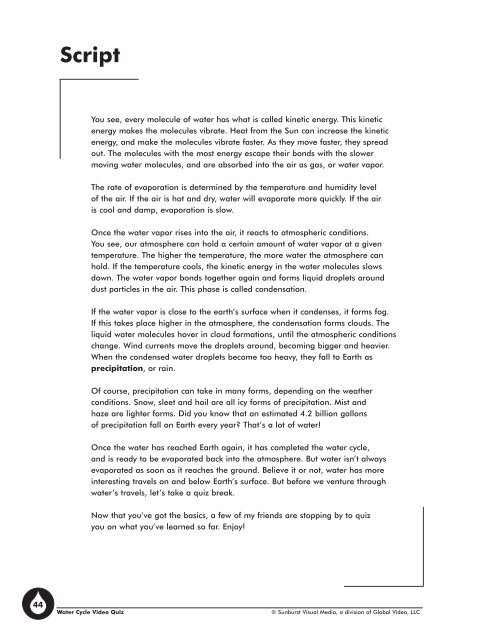Water Cycle - Marcom Projects
Water Cycle - Marcom Projects
Water Cycle - Marcom Projects
You also want an ePaper? Increase the reach of your titles
YUMPU automatically turns print PDFs into web optimized ePapers that Google loves.
44<br />
Script<br />
You see, every molecule of water has what is called kinetic energy. This kinetic<br />
energy makes the molecules vibrate. Heat from the Sun can increase the kinetic<br />
energy, and make the molecules vibrate faster. As they move faster, they spread<br />
out. The molecules with the most energy escape their bonds with the slower<br />
moving water molecules, and are absorbed into the air as gas, or water vapor.<br />
The rate of evaporation is determined by the temperature and humidity level<br />
of the air. If the air is hot and dry, water will evaporate more quickly. If the air<br />
is cool and damp, evaporation is slow.<br />
Once the water vapor rises into the air, it reacts to atmospheric conditions.<br />
You see, our atmosphere can hold a certain amount of water vapor at a given<br />
temperature. The higher the temperature, the more water the atmosphere can<br />
hold. If the temperature cools, the kinetic energy in the water molecules slows<br />
down. The water vapor bonds together again and forms liquid droplets around<br />
dust particles in the air. This phase is called condensation.<br />
If the water vapor is close to the earth’s surface when it condenses, it forms fog.<br />
If this takes place higher in the atmosphere, the condensation forms clouds. The<br />
liquid water molecules hover in cloud formations, until the atmospheric conditions<br />
change. Wind currents move the droplets around, becoming bigger and heavier.<br />
When the condensed water droplets become too heavy, they fall to Earth as<br />
precipitation, or rain.<br />
Of course, precipitation can take in many forms, depending on the weather<br />
conditions. Snow, sleet and hail are all icy forms of precipitation. Mist and<br />
haze are lighter forms. Did you know that an estimated 4.2 billion gallons<br />
of precipitation fall on Earth every year? That’s a lot of water!<br />
Once the water has reached Earth again, it has completed the water cycle,<br />
and is ready to be evaporated back into the atmosphere. But water isn’t always<br />
evaporated as soon as it reaches the ground. Believe it or not, water has more<br />
interesting travels on and below Earth’s surface. But before we venture through<br />
water’s travels, let’s take a quiz break.<br />
Now that you’ve got the basics, a few of my friends are stopping by to quiz<br />
you on what you’ve learned so far. Enjoy!<br />
<strong>Water</strong> <strong>Cycle</strong> Video Quiz © Sunburst Visual Media, a division of Global Video, LLC











